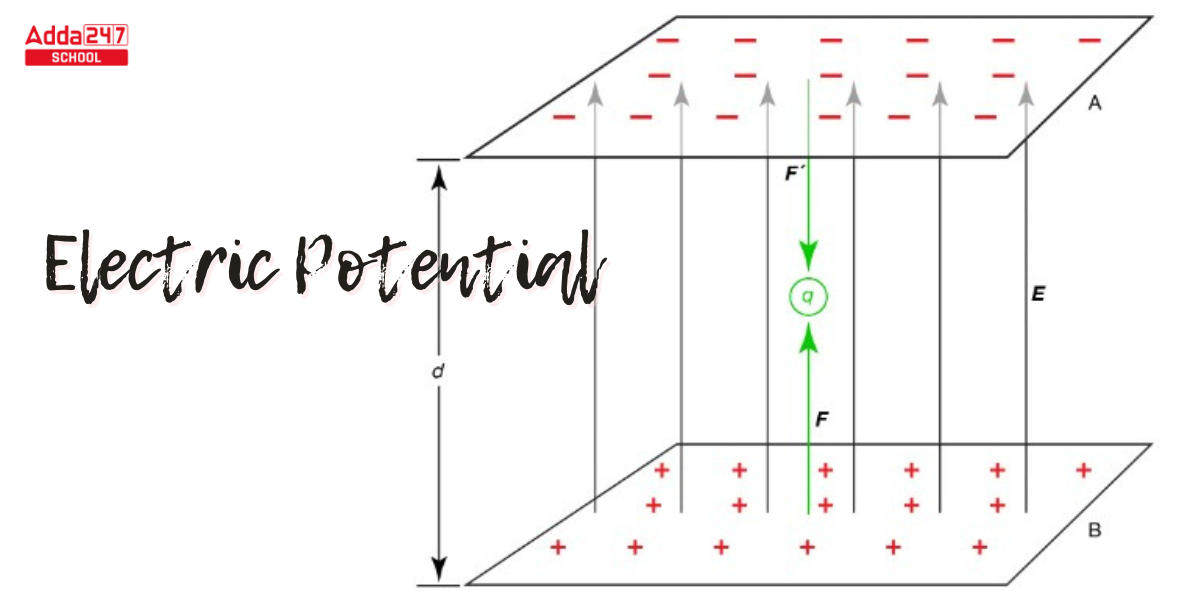Table of Contents
Potential Difference: The potential difference, in simple terms, is the difference in the total amount of energy that charge bearers have between two locations in a circuit. The difference in electric potential is commonly referred to as a voltage differential. The potential difference or the voltage is measured in volts (V). When charge carriers move through electrical components in a circuit, energy is delivered to them. A voltmeter is used to detect a potential difference or voltage.
Potential Difference
What is Potential Difference? The electric potential difference is the amount of work done per unit charge to shift a unit charge in an electric field from one place to another. The potential difference is equal to the current divided by the resistance. When one Coulomb of charge passes between two points in a circuit, a potential difference of one Volt equals one Joule of energy.
Suppose a stone is placed at a certain height on a hill. There will be some energy within the stone, the energy is known as potential energy, and if a stone is dropped from a height of A to B, the stone will always fall from a higher gravitational potential to a lower gravitational potential, resulting in a difference in both energies.
Potential Difference Symbol
The amount of work done in transporting a unit positive charge without momentum from one location to another along any path between the two points in the electric field is defined as the potential difference at any two points.
- Another word for it is the potential energy differential per unit charge or voltage. The Volt is the unit of potential difference and is represented by the letter V (Potential Difference Symbol).
- A potential difference is also defined as the amount of work necessary to move a unit of positive charge from one point to another.
- The SI unit for potential difference (V) is the volt. 1 Volt = 1 Joule/Coulomb
- 1 volt = The potential difference between two locations in a conductor that carries current when one joule of work is carried out to transfer one coulomb of charge from one point to the other.
What is Electric Potential?
The work done per unit charge to bring a charge from infinite to a point in an electrostatic field opposing the field force is referred to as electric potential. Voltage drop is another term for electric potential. Voltage or Volts is the SI unit for Electric Potential or Electric Potential Difference. A scalar quantity is an electric potential.
The diagram below depicts the forces operating on a positive charge q situated between two plates with an electric field E, A, and B. The electric force F exerted by the field on the positive charge is F = qE; therefore, an equal and opposite force (F′ = qE) must be supplied to shift the charge from plate A to plate B. W = F′d = −qEd is the work done in transferring the positive charge over a distance d.

Electric Potential Formula
Electric potential is conveyed in joules per coulomb (i.e., volts) in the International System of Units (SI), and potential energy differences are measured with a voltmeter.
⇒Work Done/Unit Charge = Electric Potential/Voltage
⇒W/q = V = Joules/Coulomb = Volts
Volts or Voltage are hence the SI units for Electric Potential.
⇒1 Joule/1 Coulomb = 1 Volt (1 volt is defined as one joule of work done to transport one coulomb of charge).
Potential Difference Formula
A potential difference is the work necessary to transfer a charge from one location to another. There must be a potential difference in current for a charge to flow between two sites.
The formula for calculating potential difference is V = I x R.
Derivation of Potential Difference Formula –
Assume there are two entities, A and B. A has +C, which is the positive unit charge that travels to body B. Some work is done while the charge moves from A to B. The POTENTIAL DIFFERENCE is the effort done while replacing +C from A to B.
Potential Difference can be denoted mathematically as V (Voltage).
The charge is symbolized by the letter C.
The total work done in transferring C from A to B is symbolized by the letter ‘C.’
As a result, the formula is V = W/C.
Potential Difference = work done / positive charge unit
The unit of work in SI is the Joule (J), and the unit of charge is the Coulomb (C).
as a result, Volt = J/C
Now, V= final voltage minus starting voltage, or VB-VA.
Work performed = Work performed from A to B or , WA 🡪B
The mathematical formula for electric potential difference is VB-VA = WA B/Q….. 1st Equation
This results in the final potential difference formula:
ΔV = W/Q
The electric potential equation is: ΔV= VB-V∞ = W∞ 🡪 B/Q… 2nd Equation
The 2nd equation indicates the electric potential, or the work done (total output) when a charge is transferred from infinity to another point.
Calculation of Potential Difference
Determine the field’s strength as E, as well as the distance between the two points is g. Using the formula, compute the potential difference between the two sites,
Divide the current flow rate by the resistance in the circuit. The result of the multiplication is the potential difference, given in volts. Ohm’s Law V = IR is the equation known as.
where, V = Voltage, I = Current, and R = Resistance are all present.
Potential Difference Unit
The potential difference or voltage is equal to the current amplified by the resistance. The SI unit of electrical potential difference is identical to the unit of electric potential, i.e. voltage or volts. When one Coulomb of charge passes between two points in a circuit, a potential difference of one Volt equals one Joule of energy.
This idea is analogous to the electrical potential difference. Electrical potential is the energy possessed by electric charges. A charge with a higher potential has more potential energy, whereas a charge with a lower potential has less potential energy. A small unit charge will result in a very modest electric field that will not alter or distort the field created by the larger charge, making the notion simple to explain.
Electric Potential vs Potential Difference
Here, you can observe the major Difference between Electric Potential and Potential below.
| Difference between Electric Potential and Potential Difference | |
| Electric Potential | Potential Difference |
| The work done per unit charge to move a charge from infinity to a position within an electric field is referred to as electric potential. | The potential difference formed while moving a charge from one place in the field to another is referred to as the potential difference. |
| Electric potential is determined at a single location. | The potential difference between two points in an electric field is defined. |
| Volts are the unit of electric potential. | unit same as the electric potential that is Volt. |
| Electric potential is assumed to be zero at infinity. | There is no such thing as potential difference. |
Potential Difference Between Two Points
Mathematically, the potential difference (V) between two points A and B in an electric field can be expressed as:
Where:
is the potential difference between points A and B.
is the work done in moving a positive test charge (q) from point A to point B.
is the magnitude of the test charge.
In practice, potential difference is often measured in volts (V), and 1 volt is defined as the potential difference that will cause 1 coulomb of charge to gain or lose 1 joule of energy.
It’s important to note that potential difference is a scalar quantity, meaning it has magnitude but no direction. The direction of electric field lines is from higher potential (positive) to lower potential (negative).
In summary, the potential difference between two points in an electric field represents the energy difference per unit charge between those points and is measured in volts. It’s a fundamental concept in understanding and analyzing electrical circuits and the behavior of electric charges.



 AP 10th Class Result 2025 OUT at bse.ap....
AP 10th Class Result 2025 OUT at bse.ap....
 CUET UG Date Sheet 2025 @cuet.nta.nic.in...
CUET UG Date Sheet 2025 @cuet.nta.nic.in...
 CUET PG Result 2025 Date [Live Update], ...
CUET PG Result 2025 Date [Live Update], ...










